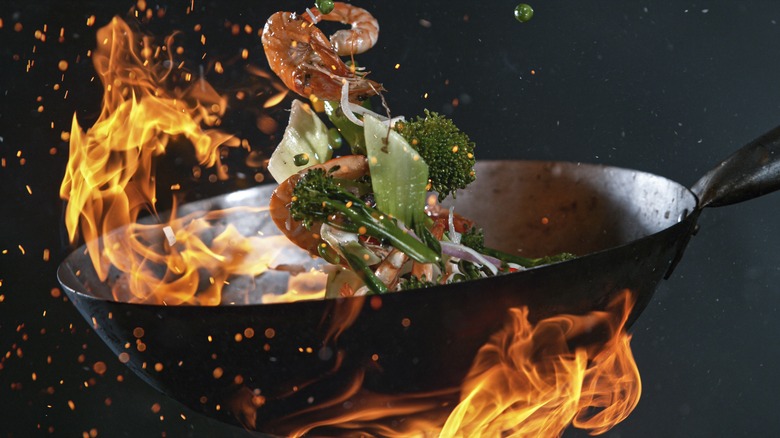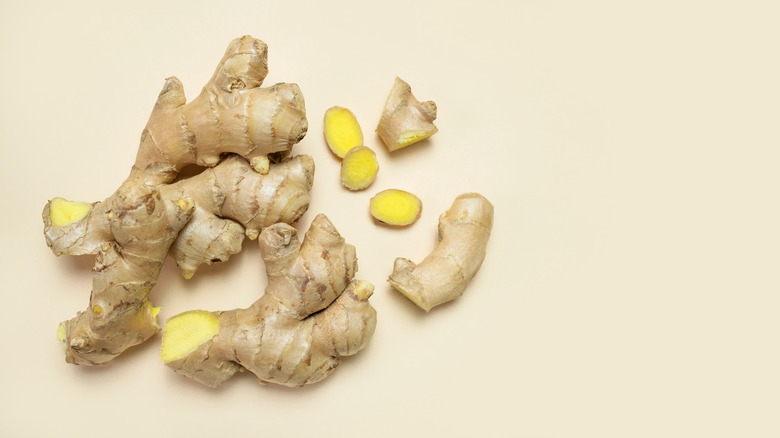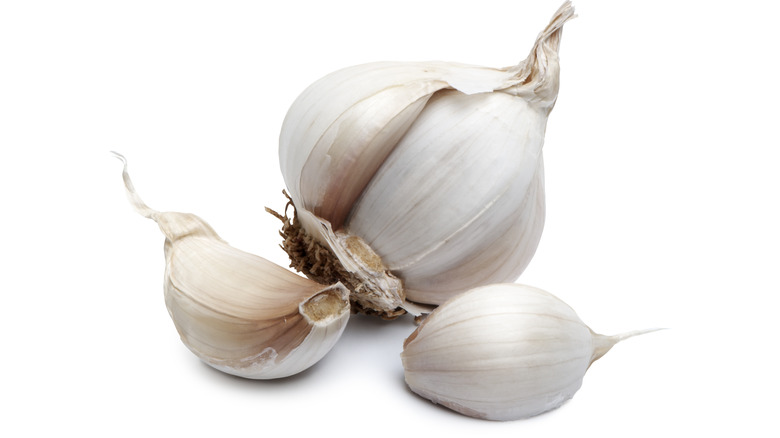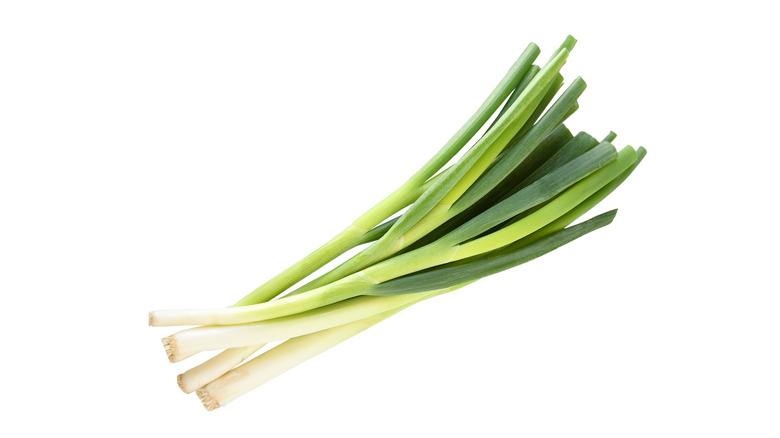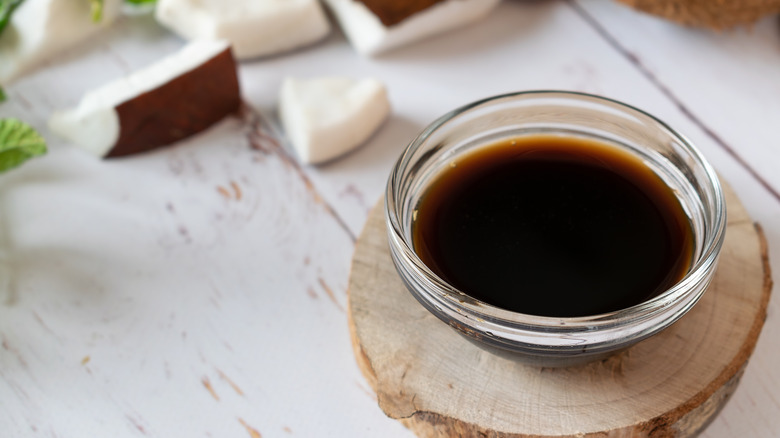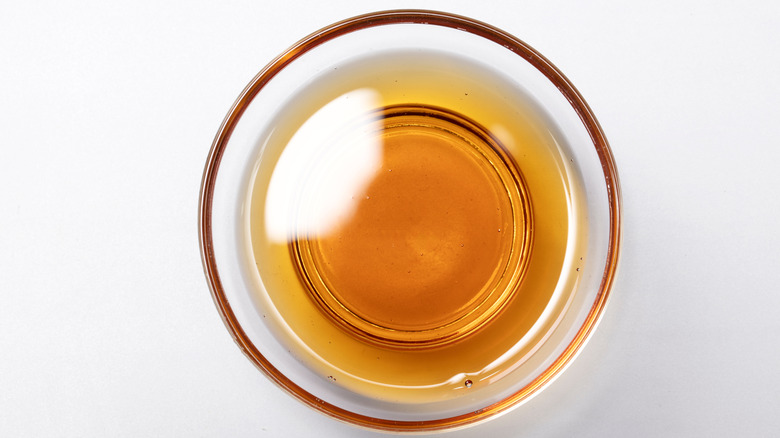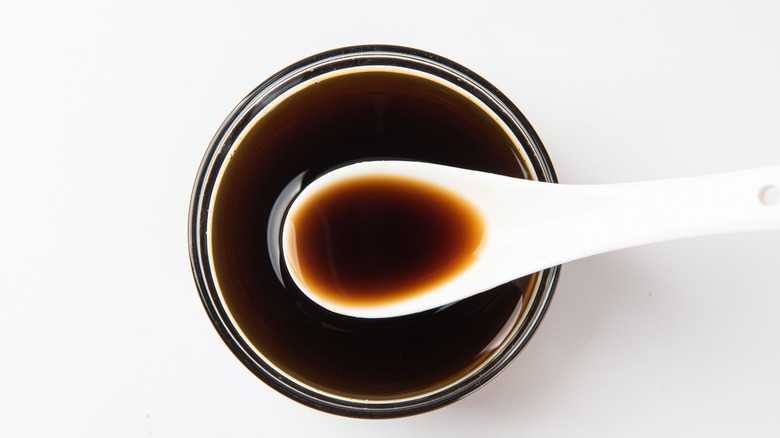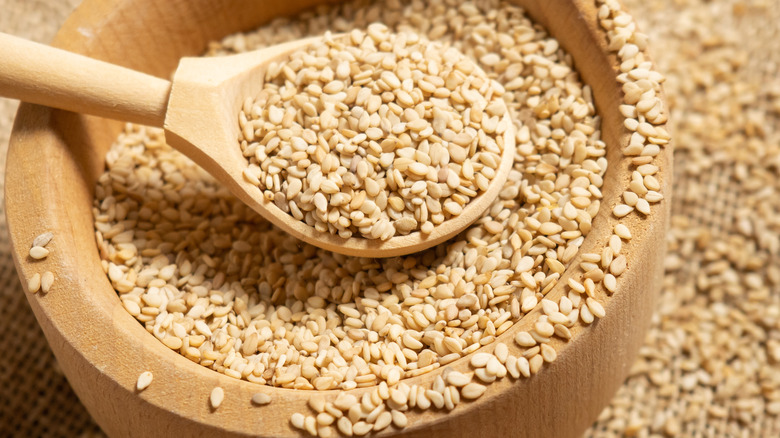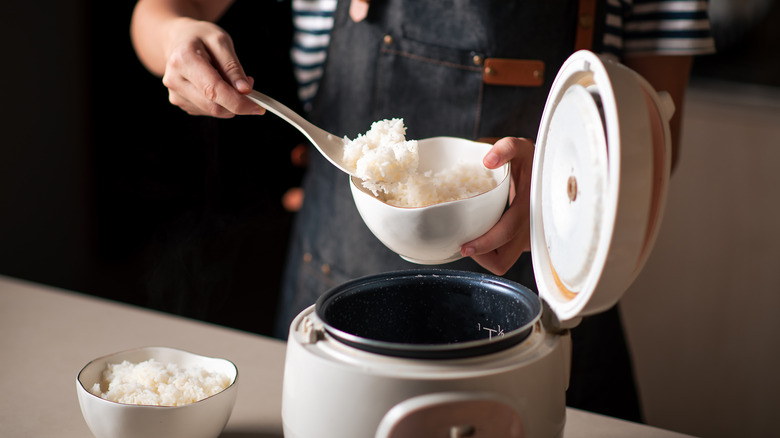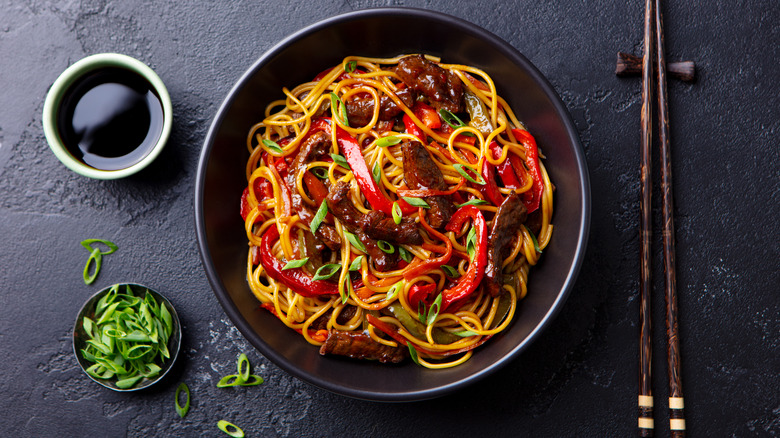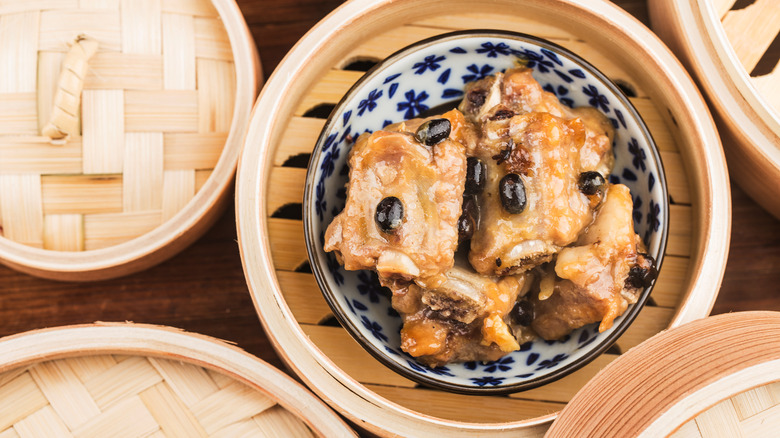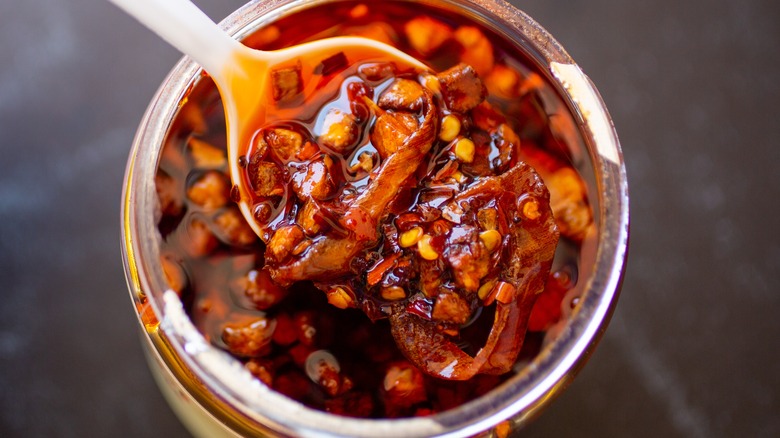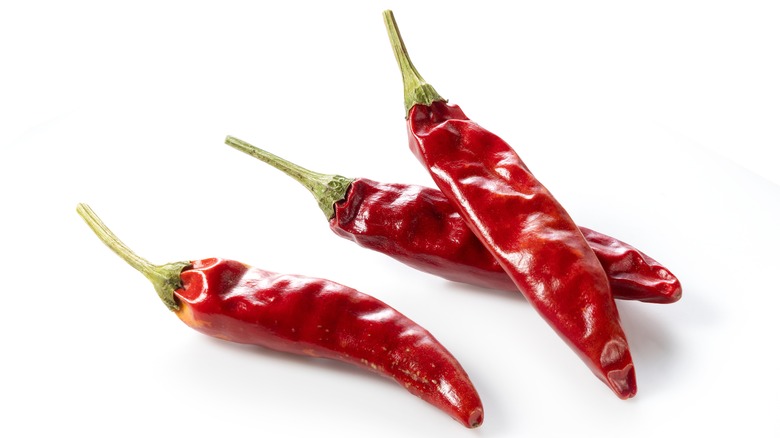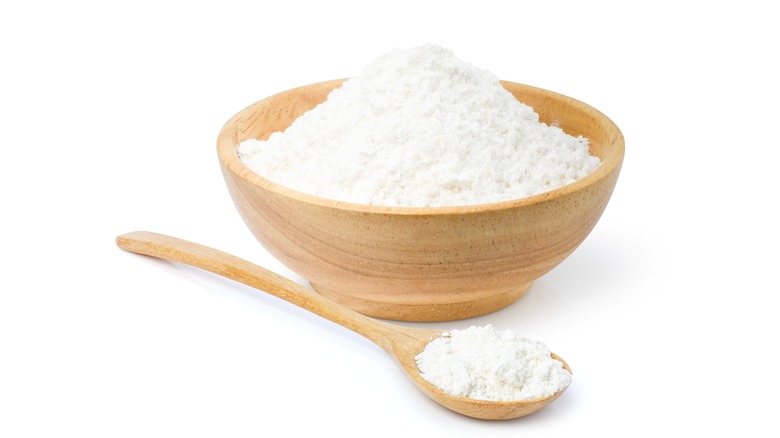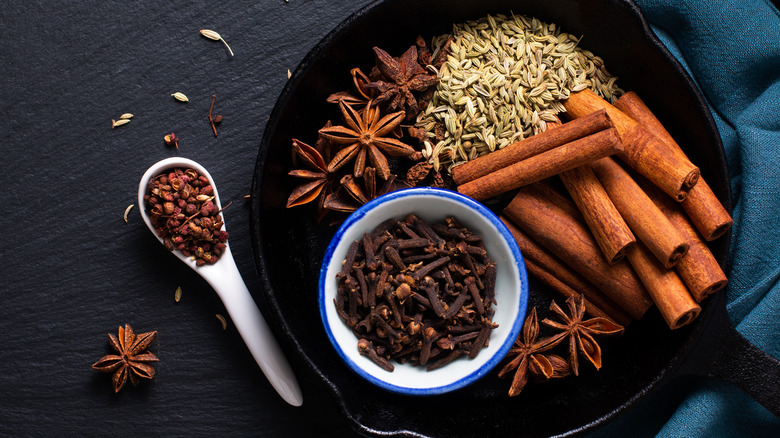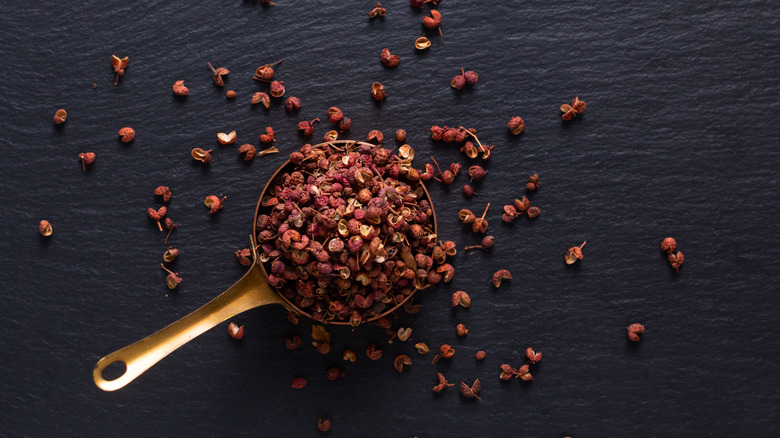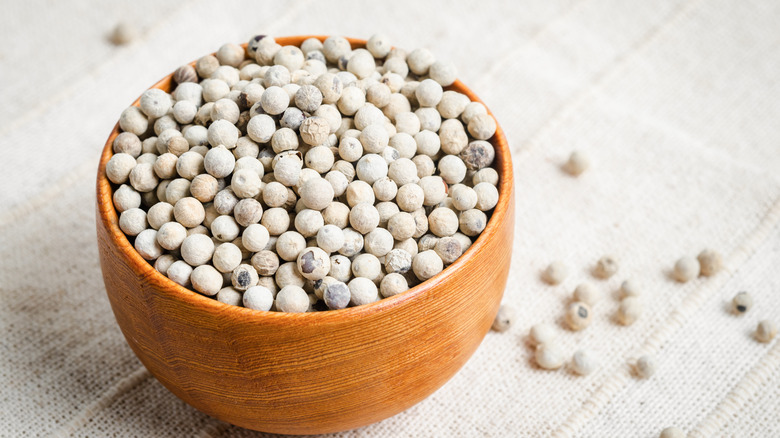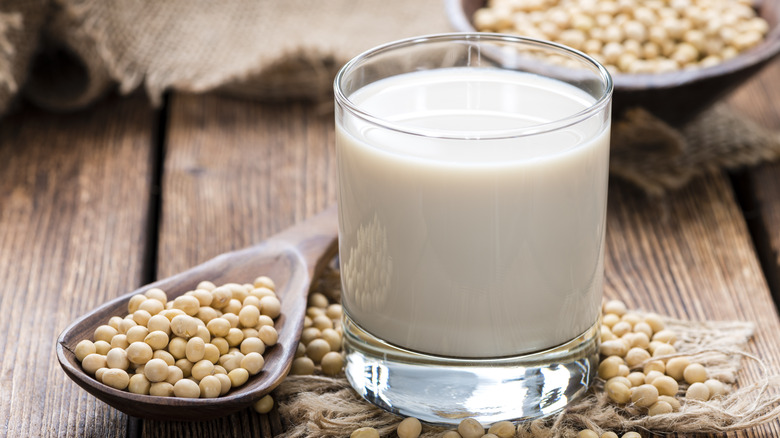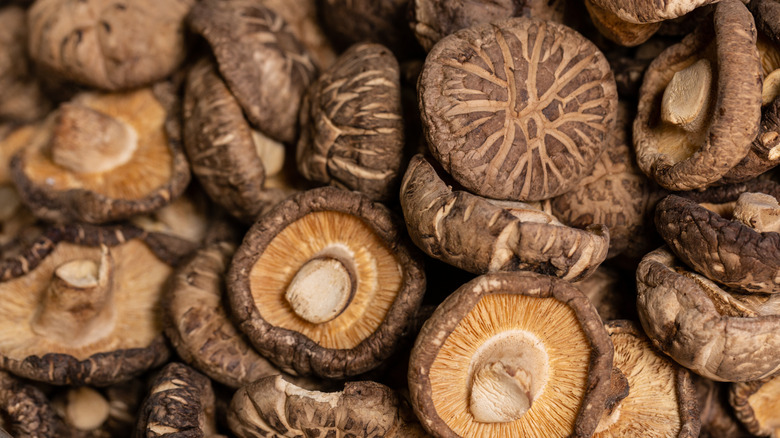20 Essential Ingredients For Chinese Cooking
Chinese cuisine is not a monolith; it's made up of many regions, provinces, and traditions, from Cantonese to Sichuan, Hunan to Fujian. Cantonese has been the most commonly served in restaurants within the U.S. primarily due to its sweeter flavor profile which appeals to Western palates, and the prominence of Cantonese people in China's first wave of immigration to the U.S. in the mid-1800s. Many from the southern region of Canton from this first wave turned to the hospitality business both as a means to make a living and to cook the food of their homeland for themselves and other Chinese immigrants.
Only much later, in 1943, after the racially-charged Chinese Exclusion Act of 1882 was overturned, did non-Chinese Americans begin to embrace Chinese cuisine. Today there are an increasing number of Chinese restaurants in the U.S., giving diners a chance to explore this intensely diverse cuisine. For cooks looking to recreate these dishes in their own homes, here are twenty ingredients we highly recommend stocking up on before firing up those woks.
Ginger
Fresh ginger root is considered an essential ingredient in Chinese cooking and is used to help achieve a vital principle of Chinese culture — balance. Ginger, garlic, and spring onion work as an aromatic base to many stir-fries and slower-cooked dishes, adding acidity, brightness, and a bit of bite to counterbalance silkier, saltier flavors like soy or oyster sauce. It is also a highly regarded ingredient, considered a warming spice in Chinese medicine, and used to help fight colds and aid digestion across many cultural practices.
When cooking across regions in China or elsewhere in Asia, balance is also struck by creating meals made from several dishes or components, which come together to offer diners a range of colors, flavors, and textures. Once again, this practice and style of eating help to include versatility, balancing out the crunchy with the soft, and the spicy with the cooling, to create a satisfying overall experience.
Garlic
Garlic is a wonderful and versatile base ingredient across many cuisines; it's always worth having some on hand. Much like ginger, garlic is often used at the beginning of the cooking process to add depth of flavor to any dish, no matter how quick or slow. Many varieties of garlic can be used within Chinese cooking, from black garlic to garlic scapes — even pickled garlic, which is used slightly differently in salads, dressings, or added to flash-fried vegetables.
Store garlic in a dark, dry place like the back of a cupboard or pantry to keep it fresh for as long as possible. Nothing makes garlic begin to sprout faster than moisture, humidity, and warmth. Depending on its environment (some of which are out of our control), whole, unpeeled garlic bulbs can last up to six months if stored properly.
Scallions
Originally from central Asia, scallions are an excellent and versatile ingredient within Chinese and other regional Asian cuisine. Scallions have the remarkable ability to be used in several ways throughout a dish. Firstly, they can be used as an aromatic and base flavor alongside garlic and ginger at the beginning of cooking. When used this way, scallions often give off a mild, slightly sweet flavor, as cooking brings out their sweeter taste.
They also make for a brilliant finish to a dish, either as a fresh, thinly-sliced, or diced garnish or as an aromatic finish when laid in chunks atop a piece of fish and then thinly coated with smoking-hot oil, creating a more acidic bite flavor when used in this manner. Lastly, scallions can be treated like another mild-green vegetable when used in classic Chinese dishes like flaky scallion pancakes.
Light soy sauce
Light soy sauce, not to be confused with dark soy sauce, is a staple ingredient in Chinese cuisine. Light soy sauce is used in numerous ways: seasoning, marinade, a final condiment added to the dish, or as a dipping sauce in Chinese cooking.
Soy sauce is made from koji-fermented soybeans. Koji, or aspergillus oryzae, is a mold predominantly used in Japanese cuisine that enriches flavors through fermentation. Koji is also used to make some of Japan's most popular ingredients, from soy sauce to saki. However, koji is thought to be from China; its remnants are found on ancient, Neothithic-age Chinese pottery.
There is more than one variety of light soy sauce, so it's worth making sure you know what you're purchasing. Japanese light soy sauce differs in flavor from Chinese light soy sauce both in its flavor and makeup. Chinese-style soy sauces are made with 100 percent soy rather than a mixture of soy and wheat, which is more common in Japanese soy sauces. These differences mean that Chinese light soy sauce tends to be more potent and saltier than their Japanese counterparts.
Dark soy sauce
Unlike light soy sauce, which tends to be used for flavoring, dark soy sauce is widely used for its color and texture. Though dark and light soy sauces are made by fermenting soybeans with koji, dark soy uses a longer fermentation process. The longer process results in a darker, sweeter liquid with a rounder flavor profile and a glossier, viscous finish. You can see this just by swirling a bottle, noticing the 'legs' or liquid droplets that linger on the glass, much like wine.
Dark soy is often added alongside light soy to achieve the ultimate balance of flavor alongside enhancing deep, rich colors. Given its potency, it should be added in small quantities to avoid overpowering other lighter flavors. It is a wonderful addition to more decadent dishes like braises and stews.
Shaoxing rice wine
Shaoxing rice wine is in a category of its own — a purchase that will enhance almost any Chinese home cooking and one we consider a must-have for any Chinese food enthusiasts. Originating in China, this fermented and aged rice wine helps to brighten and deepen flavors thanks to the enzymes produced during fermentation and its naturally savory and acidic flavors.
Original from the eastern providence of Zhejiang, it is used within many of the area's well-known dishes to create a unique sweet and savory balance associated with the region. Shaoxing is made using glutinous rice, which is then mixed with wheat and inoculated with wheat koji mold. The flavor is delicious enough to be considered a beverage and drunk on its own if desired.
Black vinegar
Any dim sum devotee will know the unique, saliva-producing pleasure of dipping a warm, plump dumpling into a cool mixture of soy sauce and black vinegar. This specific combination of flavors, a marriage between salty soy and sour black vinegar, is the perfect accompaniment to and worthy siu mai, jiaozi, or bao.
Black vinegar uses a six-month minimum fermentation process done in clay pots. The chemical reaction between the carbohydrates and the amino acids, known as the Maillard reaction, produces the darker color and the toasted caramelized flavor. This same process happens throughout cooking, from grilling a steak to brewing a cup of coffee. Black vinegar makes an excellent addition to salad dressings, steak marinades, dipping sauces, or dishes like kung pao chicken.
Sesame oil, paste, and seeds
Sesame, in its many forms, is a staple ingredient in Chinese cuisine and many others throughout Asia and the Middle East. This mainstay of the cuisine uses seeds encased in pods that grow from a flowering plant. Because the seeds contain a high yield of oil, they are also bursting with flavor, making them an ingredient that provides a massive bang for your buck, especially considering the diminutive size of the seeds.
Sesame is as versatile as it is flavorful. Sprinkling a dish with toasted white or black sesame seeds, using sesame oil as a dressing, marinade, or making a smooth paste for adding to cold noodles. However you use it, sesame adds richness, nuttiness, and a savory depth of flavor to any dish. Due to sesame oil's slow smoking point, it is essential to remember to use the oil for flavor rather than for cooking, as it is known to burn quickly when in proximity to high heat, leaving a bitter, burnt taste.
Jasmine rice
Jasmine rice is a long-grain variety native to Thailand. Slightly sweeter than other varieties like basmati, it has a fluffy, light texture, perfect for absorbing flavors and providing a satisfying texture and flavor.
One of the things we love most about Chinese cuisine is the role of the rice bowl. Traditionally steamed, jasmine rice serves as a counterbalance to flavorful meat, fish, and vegetable dishes. By serving a small bowl to each diner, the jasmine rice also acts as a sponge for all the dropped sauces and chunks of meat or vegetables that never manage to make their way from the bowl to the mouth. Whether eaten mouthful by mouthful throughout the meal or saved until last, this collection of sauce-soaked rice is a thoroughly enjoyable aspect of any Chinese feast.
Dried egg, rice, or glass (mung bean) noodles
Resourcefulness and preparation play a significant role in Chinese cuisine and culture. One of the ways this shows up is through the use of pantry ingredients, including dried and preserved vegetables, fermented sauces, and dried noodles of all varieties. These are easy things to purchase at the grocery or specialty store, then keep in the pantry or cupboard for future use. Soaking or rehydrating noodles is a quick and painless process, which means whenever hunger strikes, you're only minutes away from a delicious noodle dish.
Depending on what dish you're making or what texture you fancy, reach for a nest of dried egg, rice, or glass noodles (made from mung beans). Rehydrate first, then dab away excess water with a dish towel before tossing it into your favorite stir fry, soup, or salad. Give the dish a few stirs or tosses to coat the noodles with the sauces, and you're ready to serve.
Fermented black beans
Not to be confused with the type of beans used in Mexican cooking, fermented black beans, known as douchi, are made from black soybeans. Often paired with aromatics like garlic, ginger, and chili, fermented black beans support some of the tastiest Chinese dishes. Buying a jar of the beans, whether whole or in paste form, is worth every penny, as they pack a punch of flavor — a little goes a long way!
Fermented black beans or black bean paste pairs incredibly well with chicken, beef, pork, or tofu. They're crucial in making delicious black bean spare ribs, mapo tofu, or beef in black bean sauce. If using the fermented beans on their own, store them in an airtight container in a dark and cool place, and they'll last for up to a year or two if unopened. Once a sauce or paste is opened, it's best to keep the jar of paste or sauce in the fridge, where it will last for up to three months.
Toban Djan (chili paste) or chili oil
Toban Djan, also spelled doubanjiang, is a fermented soybean, broaden, and chili paste that packs a serious punch of flavor into every spoonful. The fermented chili paste is originally from the Sichuan province in China, an area known for its love of chilies and tongue-tingling spices like Sichuan peppercorns (also an essential ingredient on this list). Due to its makeup of both chilies and fermented soybeans, its spicy, savory flavor profile provides a lift and a kick to each dish to which its added. There are also sweeter versions of this paste, so for those looking for the spicier version, the redder the paste, the better.
Chili oil, made from a mixture of oil, seasonings like sesame, garlic, rice vinegar, and crunchy chill flakes, is also a staple Chinese condiment. While different from chili paste, it is packed with flavor and is an essential player in many of our favorite Chinese dishes, like Dan Dan Noodles. Add it to dim sum, wontons, or over-fried rice or congee for mouthwatering effects.
Dried chili peppers
Chili peppers, indigenous to the Americas, initially landed in China via the Spanish and Portuguese trade routes of the 1400s and 1500s. It didn't take long before they were absorbed into the cuisine, bringing a new form of heat to add to the collection of ingredients and spices. Today they are a beloved ingredient of the Hunan province. China grows and harvests more than 30 million tons of chilies each year, so it's no wonder they've made our list of essential ingredients for Chinese cooking!
Cooks can use dried chilis in various ways depending on the intensity of heat they're after. Whether or not you use the chili closed or open will also change the amount of heat; the seeds and membrane are the hottest parts of the fruit. Soaking to rehydrate the chili in stock or sauce and then removing will add residual but gentle heat. Frying the dried chilies in oil will create a more pungent taste. Slicing and keeping the chilies in the dishes rather than removing them will be the most intense heat of all. Depending on your tolerance and love of heat, cooks have ample choice as to which technique best fits their palate.
Cornstarch
Diners who cannot get enough of the velvety smooth, and tender texture ubiquitous to meats in many Chinese dishes might be surprised to learn cornstarch plays a significant role in achieving this melt-in-the-mouth texture. The technique is also achievable for the home cook, so Chinese food enthusiasts don't have to leave all the cooking to their local Chinese restaurant.
The meat tenderizing technique is known as velveting. It's achieved by marinating the thinly cut portions of beef, chicken, or pork in a mixture of egg white, cornstarch, rice wine, and salt for 30 minutes before cooking. Then, a quick stir fry or blanch of the meat will help seal the flavor while achieving a soft and silky texture. Cooks can then do what they like, incorporating the meat and whatever vegetables and sauces to make a delicious, restaurant-quality Chinese dish at home.
Five spice powder
Chinese five spice is an integral blend of, you guessed it, five spices (though sometimes more!) that work together to create an aromatic flavor profile ubiquitous to Chinese cuisine. Made from a mixture of cinnamon, cloves, star anise, fennel, and peppercorns, the result is a beautiful spice blend that combines sweetness, spice, warmth, bitterness, and earthiness.
A little goes a long way when using five spice in the kitchen. Rub a teaspoon onto meat to marinate to add an enormous amount of flavor. Or, use the components of five spices but as whole spices, like star anise pods, cinnamon bark, and whole Sichuan peppercorns, to add depth of flavor and complexity to your next pot of beef noodle soup. The five spice blend is yet another example of the importance of flavor balance within Chinese cuisine.
Sichuan peppercorns
Sichuan cuisine is known for its tongue-tingling properties and umami-rich flavors that leave diners craving more. Dishes like Dan Dan noodles and mapo tofu are from this region, as is one of the workhorse ingredients instrumental in creating these flavors — Sichuan peppercorns.
Not to be confused with black peppercorns, Sichuan peppercorns are berries of the prickly ash tree, native to China, and are classified in the citrus family. These berries are hand-picked and sun-dried, retaining a reddish color and a cracked open flowers-like shape rather than the round, black globe many of us associate with peppercorns. When used in cooking, Sichuan peppercorns have an interesting, if not slightly addictive, tongue-numbing or tingling results known as málà. They are a distinctive and irreplaceable ingredient and one we suggest adding to a variety of Chinese dishes to make the flavors sing. Sichuan peppercorns have also been used medicinally to treat many symptoms.
Oyster sauce
This umami-rich condiment is a versatile staple pantry item for Chinese food enthusiasts and home cooks. It's thick with viscosity and intensely salty; just a teaspoon of oyster sauce can enhance the flavors of an entire dish. Oyster sauce makes a brilliant addition to stews, braises, and stir-fries and is an incredible glaze when simply drizzled onto freshly steamed vegetables.
Interestingly, oyster sauce is an ingredient that was an accidental invention. It's a product of Lee Kum Kee's founder, Lee Kum Sheung's forgetfulness. Having left a pot of oysters on the stove to cook for far too long, Kum Sheung was left with a caramelized brown gravy that packed a punch of flavor. Lee Kum Kee has been manufacturing a version of this original happy mistake for over 130 years, a much-loved favorite in Cantonese cooking.
White pepper
White pepper, while not hugely commonplace within many European cuisines, is often used in Chinese and other Asian cuisines. If you cook from Asian regions with frequency, it's worth keeping a jar in the cupboard. Though white peppercorns and black peppercorns begin their life from the same plant, white peppercorns, only picked when fully ripe, are then fermented and dried, the outer layer removed. These processes result in a smoky product with a distinctive sharpness and added fruitiness.
White pepper is a crucial ingredient in hot and sour soup, egg drop soup, and salt and pepper tofu, squid, or other such dishes. Though it may be tempting to replace white pepper with black, unless, in small quantities, the results will be pretty different, it's worth having white pepper to hand for these occasions.
Soybeans and soymilk
Long before any of the 'mock' meats we know today existed, tofu, made from soybeans, was a cornerstone ingredient, appreciated for its own value rather than as a meat alternative, and eaten across Chinese and other Asian cuisines. Used in various desserts and dishes across the continent of Asia, fresh soy milk is also a delicious and popular drink, especially in cultures with high levels of lactose intolerance.
While soybean products are used across the country, Chinese desserts, in our opinion, are one of the most overlooked aspects of the cuisine and are long overdue for their moment of fame. Many provide a gentle, creamy, or cooling end to a flavorful meal.
Creamy desserts like tofu pudding, douhua, or tao fu hua, depending on what region in China you're in, are an excellent and satisfying way to end a meal and worth making at home. Topped with a sweet syrup made from ginger and brown sugar as a dessert or savory items as a snack, this dish alone is worth splashing out on a bottle of soy milk or making soy milk yourself from soybeans.
Dried shiitake mushrooms
Chinese cuisine values many dried pantry ingredients to flavor dishes as they hydrate, from dried shrimp and goji berries to mushrooms. While mushrooms of all shapes and sizes are a foundational ingredient in Chinese cuisine, dried mushrooms are often favored over fresh. Their earthy, concentrated flavor becomes a seasoning used to add depth of flavor and balance to a dish. Varieties like wood ear, black mushrooms, lily flowers, and shiitake are among the favorites.
Shiitake mushrooms are native to East Asia, which is why they are prevalent in Japanese, Chinese, and other East Asian cuisines. Rich in B vitamins, copper, selenium, manganese, and iron, these mushrooms, alongside other varietals, are also a part of Chinese medicine practices and cuisine, a principle often found in cultures that support the idea of food as medicine. A jar of dried shiitake mushrooms will last for ages if stored properly in a dry, dark climate. Add a few to water or stock to rehydrate, then chop up and toss them into your next stir fry.
